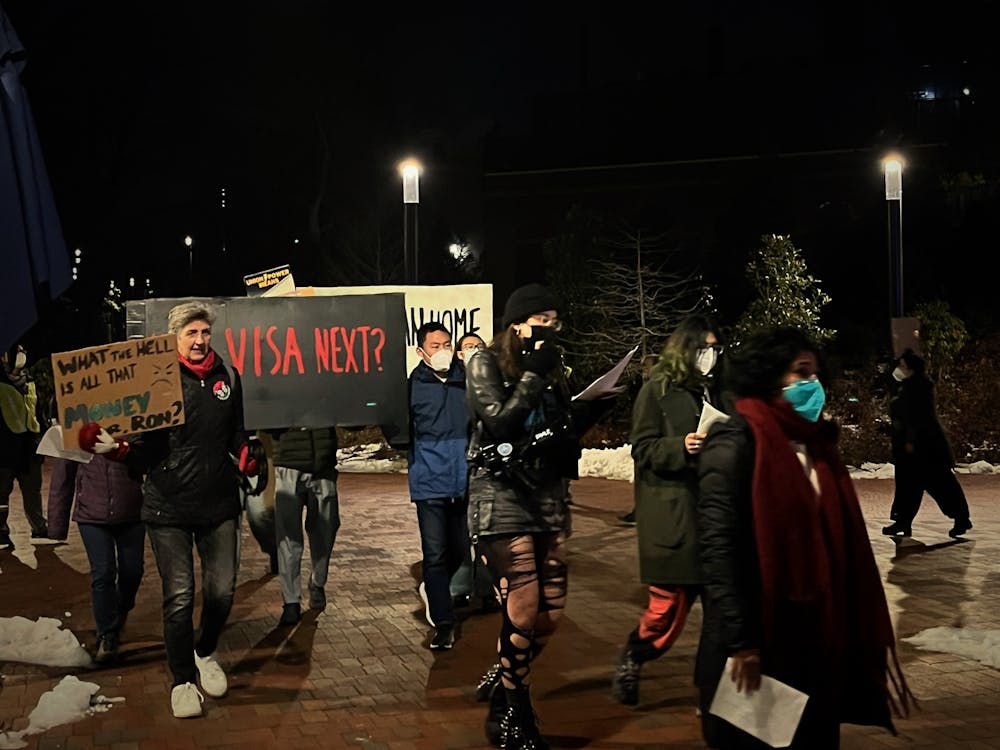On Tuesday night, Dean of the Krieger School Katherine S. Newman and Dean of the School of Education David W. Andrews led a conversation in Boston on the future of American cities as part of the University’s capital campaign, “Rising to the Challenge: The Campaign for Johns Hopkins.” The event focused on the University’s new Institute for the American City — one of President Ronald J. Daniels’ Signature Initiatives — and the role universities can play in redeveloping urban cities and schools.
This discussion, which was also streamed online, delineated the University’s plans for what Trustee Heather Murren called the largest and most ambitious Johns Hopkins campaign yet.
Murren explained that Hopkins is fully equipped to tackle lofty issues such as poverty, segregation and urban decline because it has all three tools needed to succeed in this ambitious endeavor: brilliant people, collaboration between disciplines and funding.
22,000 people have contributed to the third ingredient, helping to raise half of the $2.25 billion goal.
“Philanthropy can change the state of play, as we’re about to discover,” Murren said.
Half of the global population lives in cities, but such urban centers have suffered depopulation since the 1950s. Baltimore in particular has lost a third of its population to urban flight after the loss of manufacturing and is now experiencing a 22.4% poverty rate, according to the U.S. Census.
The introduction of the event explained a sentiment that much of the Hopkins community shares: We are not just located in Baltimore; we are of Baltimore.
Newman focuses her research on the working poor. In connecting her expertise to Baltimore, she explained the timeline of the Rust Belt cities and the ways in which they declined in conjunction with the loss of American industry.
“Cities were the heartland of industrial America,” Newman said. Those urban centers, like Flint, Syracuse and Baltimore, felt a demographic shift beginning in the 1970s when the jobs that sustained them were either moved to the south or sent offshore.
At the turn of the century, some cities, such as Boston and Providence, experienced gentrification and revival as people moved back into the city and the poverty trickling out to the suburbs. Other cities, like Baltimore and Detroit, are stuck.
Newman explained the symptoms of such stagnation in Baltimore: high poverty rates, single-parent households, abandoned housing, public safety, high tax rates and low tax resources.
There is hope, though.
“President Daniels has committed himself and committed this institution to being part of the solution,” Newman said.
Other cities want to be part of this initiative and to take the measures that work in improving the conditions in Baltimore and import them to their own cities. Newman believes this could build a network of older, industrial cities that can attack specific issues like childhood obesity, high school dropout prevention and workforce training in an efficient way.
“If we crack the problem of childhood obesity in Baltimore, can Flint do the same?” Newman asked.
Similarly, other schools of the same caliber as Hopkins have begun to tackle issues in their own cities: Yale in New Haven, Conn., Harvard in Cambridge, Mass. and Brown in Providence, R.I.
“Most of us care about the cities we’re located in,” Newman said. “What makes us special is our plan to integrate the city into the plan itself.”
Solutions, Newman explained, come from knowledgeable leaders, so it is important that Hopkins encourages its youngest students to become well versed in social policy. The Social Policy minor is the first step the university has taken towards that end in order to induce an interdisciplinary study of economics, political science and sociology through the lens of social programs.
Newman was excited to announce the restoration of the Parkway Theatre, an iconic structure built as a silent movie theater in 1915 that was left to decay in the 1960s. Baltimore City has given the structure to Hopkins, which will station its undergraduate and graduate film programs there once it is restored. The theater will also show Hopkins and MICA student films.
Newman hopes that this will begin to build the arts and culture backbone needed to establish Station North as an arts neighborhood and to attract the consumers that have previously fled the city.
As dean of the School of Education, Andrews’ focus is on underprivileged and at-risk children and youth and their academic and behavioral trajectories.
His idea of an effective school consists of high quality teachers and leaders, engaged families and students and personalized, evidence-based approaches. “It’s about people,” he said.
Andrews knows this is a widely shared belief, but one much more complicated than the average person may expect. “We don’t have [leaders] in the areas we need them most,” Andrews stated.
He believes schools have the potential to move away from teaching to the middle, an approach that has existed for the last couple hundred years. At the new $53 million Henderson-Hopkins School in east Baltimore, cutting-edge technology and research will be used to educate 720 students from the age of 6 weeks through the 8th grade. The 7-acre campus is dedicated to a mixed-income population, with priority given to those who live and work in the neighborhood. The school will open on Jan. 2, 2014 and begin to work towards its founding principle: to maximize growth for every individual student.
Through the Institute for the American City, Hopkins will play a major role in revitalizing Baltimore City via its housing, schools and people. “Audacious is exactly what we expect Hopkins to be,” Murren said.




